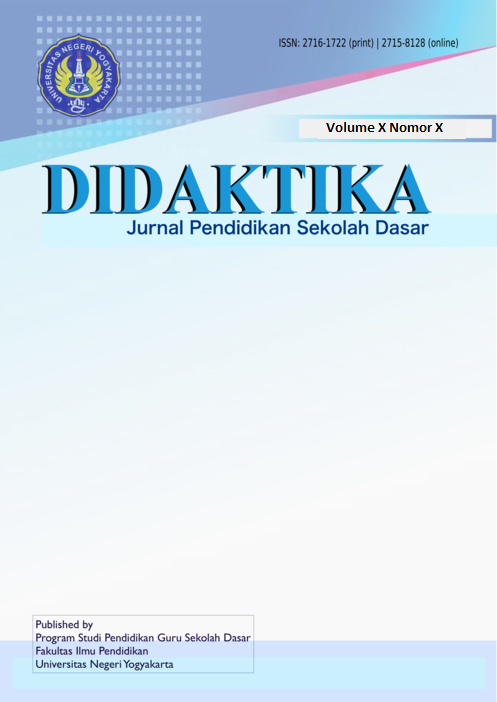Upaya Meningkatkan Minat dan Hasil Belajar Siswa Kelas IIII melalui Model Pembelajaran Numbered Heads Together Pada Mata Pelajaran Matematika di SDN Perwira II Bekasi Utara
DOI:
https://doi.org/10.21831/didaktika.v1i1.28084Abstract
This study aims to increase the interest and learning outcomes of class III students through a joint head-numbered learning model on mathematics subjects at North Bekasi Second Elementary School. This type of research uses Classroom Action Research which consists of 2 cycles. Backpack subject 23 students. Data collection techniques consist of observation sheets and essay tests.Based on research, interest in the first cycle obtained an average value of 76.45 with a percentage of 73.91% and the second cycle obtained an average of 86.96 with a percentage of 86.96%. Then, the learning outcomes in the first cycle obtained an average value of 74.18 with a percentage of completeness of 69.57% and the second cycle obtained an average value of 86.96 with a percentage of completeness of 82.61%. This shows that the Numbered Heads Together model can increase the interest and learning outcomes of class III students in Mathematics at North Bekasi Second Elementary School.
References
Adnan, dkk. (2016) Perkembangan Peserta Didik. Jakarta: Universitas Negeri Jakarta.
Aqib, Z. (2013) Model-Model, Media, dan Strategi Pembelajaran Kontekstual (Inovatif). Bandung: Yrama Widya.
Kurniasih, I & Berlin S. (2017) Ragam Pengembangan Model Pembelajaran Untuk Peningkatan Profesionalitas Guru. Jakarta: Kata Pena.
Priansa, D.,J. (2017) Pengembangan Strategi Dan Model Pembelajaran. Bandung: Pustaka Setia.
Suprijono, A.(2014) Cooperative Learning Teori Dan Aplikasi Paikem. Yogyakarta: Pustaka Pelajar.
Susanto, A. (2013) Teori Belajar & Pembelajaran di Sekolah Dasar. Jakarta: Prenadamedia Group.
Wartini, S. (2012) Minat. Yogyakarta: Universitas Negeri Yogyakarta. (diakses pada tanggal 27 Juli 2017).
Downloads
Published
How to Cite
Issue
Section
Citation Check
License
- Authors retain copyright and grant the journal right of first publication with the work simultaneously licensed under a Creative Commons Attribution License that allows others to share the work with an acknowledgement of the work's authorship and initial publication in this journal.
- Authors are able to enter into separate, additional contractual arrangements for the non-exclusive distribution of the journal's published version of the work (e.g., post it to an institutional repository or publish it in a book), with an acknowledgement of its initial publication in this journal.
- Authors are permitted and encouraged to post their work online (e.g., in institutional repositories or on their website) prior to and during the submission process, as it can lead to productive exchanges, as well as earlier and greater citation of published work.






